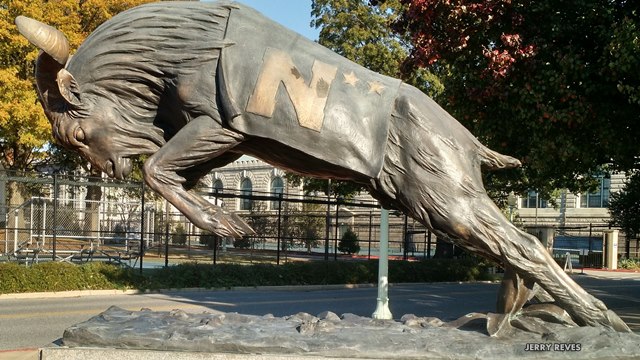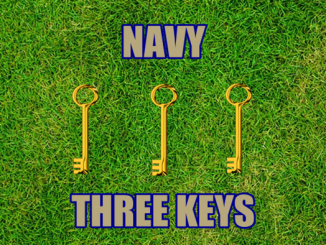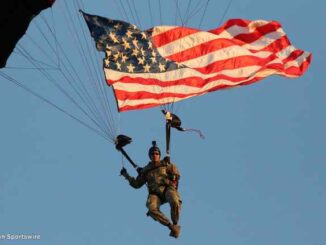
The 2020 pandemic season was, in so many ways, a throwaway season. Players did not have full access to the resources they normally have. Training table, practice hours, open facilities, you name it: In 2020, players did not have the full complement of options for physical and holistic development.
They weren’t able to spend as much practice time on the field with their coaches as they normally would have. So many aspects of the season were disrupted and thrown way off track. A season was ultimately played, but not under conditions which resembled anything close to normal.
Therefore, when Navy was completely obliterated by BYU in a Week 1 game, after an offseason in which coach Ken Niumatalolo – worried about the safety of his players in a very uncertain time – understandably refrained from having his players practice in pads. Remember: We didn’t know in the early months of 2020 if playing football was a safe activity. No one did. It was only with great uncertainty that football lurched forward and got off the ground that year. Thankfully, the act of playing a football game in an empty or minimally-populated stadium was not a superspreader event. The 2020 season came and went. When the 2021 season arrived, we had something far closer to normal in college football: Not a 100-percent restoration, but reasonably close.
There was spring practice. There was training table. It looked and felt a lot more like a normal college football season, even though the pandemic had not ended. It’s true that some bowl games were not played in 2021 due to COVID complications, but on a much broader level, the season contained a lot of the normalcy (chiefly the presence of fans and cheerleaders) we had sorely missed in 2020.
This return to normalcy brought with it the hope in Annapolis that Navy would be much better, much tougher, and chiefly much more formidable on the offensive line. The Midshipmen were blasted at the start of 2020 due to the lack of padded practices, so when 2021 began after a much more normal offseason, the goal was to become a rugged and flinty team with an offensive line which would enable the triple option to roar back to life.
That did not happen.
 The Week 1 blowout which happened in 2020 against BYU recurred in 2021 versus Marshall. The offensive line’s inability to start quickly out of the gate in 2020 was replicated in 2021. A 49-7 loss to Marshall and then a 23-3 loss to Air Force in Week 2 poured the same bucket of cold water over the 2021 season which also drenched the 2020 season. Navy absorbed a couple of haymakers and lost confidence in September, before its season had a chance to get off the ground.
The Week 1 blowout which happened in 2020 against BYU recurred in 2021 versus Marshall. The offensive line’s inability to start quickly out of the gate in 2020 was replicated in 2021. A 49-7 loss to Marshall and then a 23-3 loss to Air Force in Week 2 poured the same bucket of cold water over the 2021 season which also drenched the 2020 season. Navy absorbed a couple of haymakers and lost confidence in September, before its season had a chance to get off the ground.
Two straight years, Navy has failed to start its season well. Two straight years, Navy’s offensive line has been overwhelmed and outclassed in September. We can discuss the meat of the AAC season in October and November if we want to, but if there is a first priority for the Midshipmen in 2022 – preceding the big Commander-In-Chief’s Trophy games against Air Force and especially Army – it is for the Midshipmen to dramatically improve their offensive line play, such that they can thrive in September and build confidence through the whole season, instead of entering late September in desperation mode.
If Navy can fix its September problems on offense, the defense is going to benefit. Last year’s defense did a fine job, holding opponents under 29 points per game. In past years, when Navy had strong offensive lines and deft quarterbacks who could take advantage of that asset up front, it was expected that Navy would average 30 points per game over the course of a season. Usually, when Navy does crack the 30-point mark in a season, it goes to a bowl game. The defense doesn’t even have to be spectacular for that to happen.
Consider the 2016 season, when Navy went 7-1 in eight AAC games and reached the AAC Championship Game before losing to Temple. Navy produced a nine-win season with a division championship despite allowing 31 points per game. Why? The offense averaged 37.
Navy’s best seasons occur when the defense is elite. Navy won 11 games in both 2015 and 2019 when the defense did not allow more than 22 points per game. It’s true that when the defense dominates, Navy can reach the top tier of college football. However, in terms of maintaining the consistency which has marked so much of the Niumatalolo era in Annapolis, the centerpiece of the operation is the triple-option offense. Cranking out 30 to 35 points with great regularity has been the cornerstone of a successful program.
The last two years – weighed down by extremely unproductive and impotent Septembers – the Midshipmen have scored fewer than 21 points per game. That’s right: fewer than three touchdowns per game.
No one is asking Navy to score 42, 49, or 56 points per game. Heck, not even 38. If Navy can just get back to an average of 31 to 34 points per game, the program should get back to a bowl game and rediscover the joy of a winning season.
It starts in September. It starts on the offensive line. It starts with a great coach, Ken Niumatalolo, rediscovering his fastball.
It is easy to wonder if Navy’s coach has lost the magic touch. True, he beat Army, which reminded everyone in Annapolis that he can still win the one game which matters the most to the Navy family. Yet, when a coach thrives on the scope and scale Niumatalolo did – from the time he took over from Paul Johnson through that magnificent 2019 season – and then runs into two straight disastrous seasons in 2020 and 2021, it’s entirely natural to wonder if a coach can deliver the goods once again.
Niumatalolo deserves trust. Moreover, he has earned it. If anyone harbored severe doubts about the direction of the program, the win over Army should have quieted them.
Yet, even if you do trust Niumatalolo (as I do, in case you were wondering), we can all allow ourselves to wonder: What if this season is just like 2020 and 2021? What if this season has another slow start? What if this season, like the past two, features inadequate offensive line play? What then?
Navy won only three games in 2018, and it felt like the end of the world. In 2019, Navy won 11 games. No, this doesn’t mean we should expect Navy to win 11 games (or even 10) this year. The point of that particular recollection is that when Navy has had a bad season in the past, it has been followed by a good season. The 2018 and the 2011 seasons were both isolated aberrations.
Now, for the first time in his storied tenure, Niumatalolo is facing the possibility of three straight seasons without a bowl, three straight seasons without a winning record.
Given all he has achieved at Navy, one could legitimately and fairly say Ken Niumatalolo has nothing left to prove. I would offer this point: He does have to prove that he can stabilize the program, at least one more year, one more time. A good season this year means no one will question if he has lost his fastball.
A coach, a program, and an offensive line unit all need to be ready to answer the bell in September.



Be the first to comment